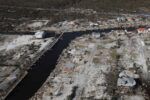Dorian crawls toward US coast, weakening to Category 2 storm
This satellite image obtained from NOAA/RAMMB Hurricane Dorian as it sits over the Bahamas (HO)
Port Saint Lucie (United States) (AFP) – Hurricane Dorian crept towards the southeast coast of the United States on Tuesday, weakening slightly but remaining a dangerous storm after leaving a trail of death and destruction in the Bahamas.
At least five deaths have been reported in the Bahamas from a storm which Prime Minister Hubert Minnis called a “historic tragedy” for the Atlantic archipelago.
The Miami-based National Hurricane Center (NHC) said Dorian, which has dumped as much as 30 inches (76 centimeters) of rain on the Bahamas, had been downgraded from a Category 3 to a Category 2 storm on the five-level wind scale.
At 11:00 am (1500 GMT), it said Dorian was packing maximum sustained winds of 110 miles (175 kilometers) per hour, down from 115 mph, the NHC said.
Dorian was located about 105 miles east of Fort Pierce, Florida, and moving in a northwesterly direction towards the Florida coast at a snail’s pace of two mph, it said.
The NHC said Grand Bahama Island was continuing to experience dangerous winds, life-threatening storm surge and extreme flooding from the heavy rain.
The hazardous conditions would continue through much of Tuesday on Grand Bahama Island, which is the northernmost island in the archipelago and home to its largest city, Freeport, the NHC said.
It said Dorian was expected to pick up speed and grow in size during the day and turn towards the north on Wednesday evening.
“The hurricane will then move dangerously close to the Florida east coast late today through Wednesday evening, very near the Georgia and South Carolina coasts Wednesday night and Thursday, and near or over the North Carolina coast late Thursday and Thursday night,” the NHC said.
As Dorian ground to a standstill over the Bahamas, the tourism and aviation ministry announced the start of rescue operations “in parts where it is safe.”
– ‘We are under water’ –
For many, the wait for help to arrive has been terrifying.
A text message seen by AFP from a woman named Kendra Williams, who lives on Grand Bahama, said: “We are under water; we are up in the ceiling. Can someone please assist us or send some help. Please. Me and my six grandchildren and my son, we are in the ceiling.”
Fear gripped residents of Freeport as winds tore off shutters and water began entering homes, Yasmin Rigby said by text from the Grand Bahama island’s main city.
“People who thought they were safe are now calling for help,” Rigby said. “My best friend’s husband is stuck in the roof of their house with seven feet (two meters) water below.”
Initial Red Cross estimates were that 13,000 buildings may have been damaged or destroyed by Dorian in the Bahamas, officials in Geneva said.
Video posted on the website of the Tribune 242 newspaper showed water up to the roofs of wooden houses in what appeared to be a coastal town. Capsized boats floated in muddy brown water clogged with debris.
Florida has started to feel the effects of Dorian, with heavy rain and strong gusts of wind reported.
More than 9,500 people have taken cover in 121 shelters in Florida, according to the state’s Division of Emergency Management.
Among them was 30-year-old Stefanie Passieux, who took shelter along with her two children and mother.
– ‘Get out NOW’ –
“I came yesterday, as soon as it opened. They said we were in a state of emergency so I came,” Passieux said.
“My dad is staying with the cats, but we left. He never leaves. He doesn’t do shelters.”
Florida senator and former governor Rick Scott wrote on Twitter that “a slight wobble West” would bring the storm “on shore with devastating consequences.”
“If you’re in an evacuation zone, get out NOW. We can rebuild your home. We can’t rebuild your life.”
In southern Florida’s Port Saint Lucie — a low-income area where mobile home parks stood all-but emptied of their residents — Dan Peatle, 78, fled his retirement community to take shelter in a hotel.
“It makes me sick. I don’t like it,” he told AFP as he stepped outside for air before the storm closes in.
“I’ve been through seven or eight of them since I’ve been in Florida, since ’73. And, they’re all the same, you know. Tear everything up, put it back together.
“But, I chose to live here so I might as well live with it, you know.”
Disclaimer: Validity of the above story is for 7 Days from original date of publishing. Source: AFP.


